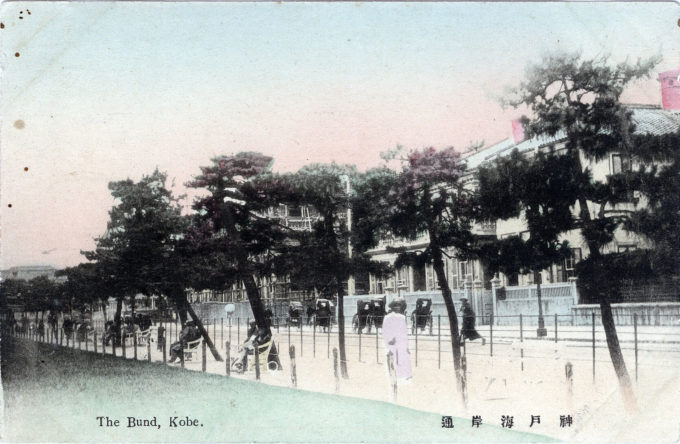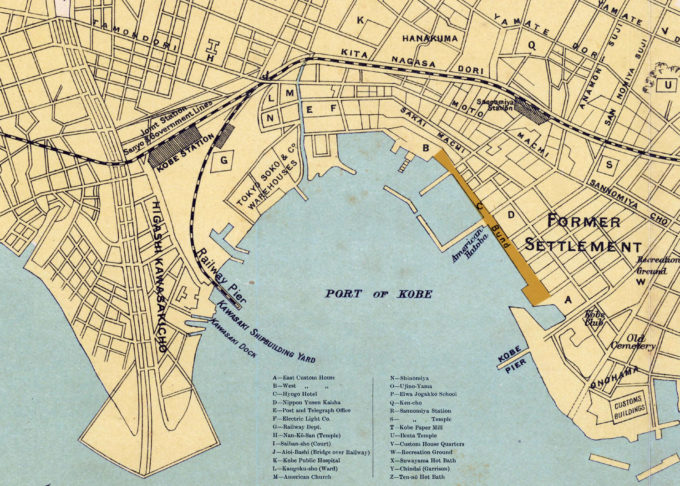See also:
Oriental Hotel, Kobe, c. 1910.
American Hatoba (Wharf), Kobe, c. 1910.
“The dawn is no longer poetically heralded by the deep booming of the temple bell, but by the shrill blasts of steam hooters and sirens whose strident notes fall discordantly upon the ears of those whom they awaken, and remorselessly upon the ears of those whom they summon to the daily task in factory or workshop.
“… Despite its commercialism, none more than the Kobe people strive to retain the picturesqueness which characterizes the port. Though its 41 banks are indications of modernism, its 90 Buddhist temples and 74 Shinto shrines remain to impart a pleasing ecclesiastical flavor to the city. The booming temple bells still compete with the ear-splitting steam whistles of the ‘foreign devils,’ and the satisfying tenets of Buddhism are preached side by with those of the Occidental Christians.
“… Few Japanese ports have so many places of beauty and interest near by, and few offer more creature comforts to the tourist seeking such. Days or even weeks may be spent contently, according to one’s temperament. The social life among the foreigners (who are hospitable to a fault) is delightful, and the recollections one carries away of the city and its people are not soon forgotten.
“Many of the streets of the Settlement are shaded by fine old acadias, maples, pines, willows, and flowering specimens of the Paulownia imperialis. A massive sea-wall runs along the attractive foreign Bund, and the luxurious houses which stand back from it impart an air of prosperity and solidity not always features of Japanese ports.”
– Terry’s Japanese Empire, by T. Phillip Terry, 1914
“The view of Kobe from the steamer is that of a modern and well-built city. You see a well-built jetty and some handsome buildings and a shady road along the water, which is the Bund … Kobe was founded as a foreign settlement in 1868 and it has gone ahead so rapidly that its imports and exports now exceed those of any other city in Japan except Yokohama.
“… I found the streets in the foreign quarter of Kobe very attractive. They are broad and well provided with shade trees. The street called Kyo Machi on which the Oriental Hotel is, was one of the finest, though are others nearly as good. The shade of the trees was most grateful during the very hot weather I encountered in Kobe.
“Though it was hot, 90 degrees Fahrenheit or over, the heat was not unbearable like the heat in Hongkong but the air has usually some life to it. Often it was beautifully clear, giving a fine view of the hills over which great masses of white clouds frequently hung, forming a fine contract to the azure blue of the sky.
“The bund at Kobe is more elaborate than the one at Nagasaki. At Kobe, there is a boulevard running along by the water’s edge, while a fine sea wall gives a finish to the street whether seen from the land or water.”
– “Around the World for the Northwestern Miller: Kobe”, by Kingsland Smith, The Northwestern Miller, December 16, 1903




Pingback: Motomachi-dori, Kobe, c. 1930. | Old TokyoOld Tokyo
Pingback: “Great Kobe Harbour”, c. 1960. | Old TokyoOld Tokyo